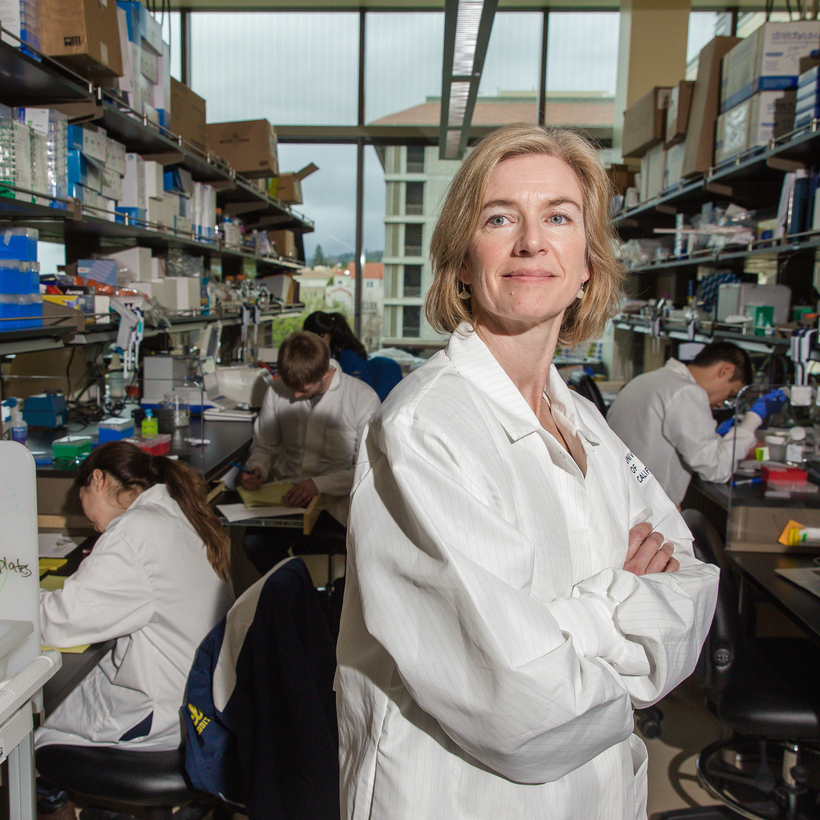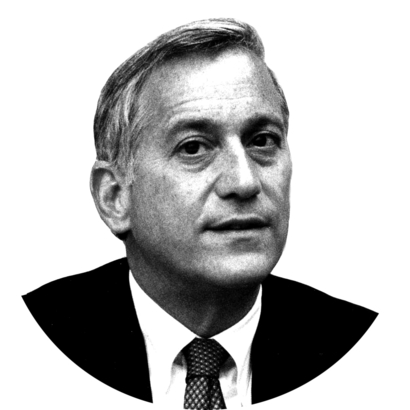The Berkeley campus was almost deserted when the group began to gather. It was Friday, March 13, the day that all classes were canceled. The dozen researchers sat carefully distanced from each other in the ground-floor conference room of the Innovative Genomics Institute (I.G.I.), and another 50 of their colleagues from throughout the Bay Area joined remotely by Zoom. In the front stood the scientist who had summoned them, Jennifer Doudna, famed for her work on the gene-editing tool known as CRISPR.
The topic wasn’t CRISPR, at least not directly. Instead, displaying the intensity that she usually keeps masked by a calm, understated façade, Doudna was issuing a rallying call for academic researchers to tackle the spread of the new coronavirus. The government had failed spectacularly in providing testing for the virus, so it was time for professors and graduate students, clutching their test tubes and raising their micropipettes high, to rush into the breach. “This is not something that academics typically do,” Doudna said. “We need to step up.”
It was fitting that a virus defense was being led by a CRISPR pioneer. The gene-editing system that Doudna co-discovered is based on a virus-fighting trick used by bacteria, which have been battling viruses for about three billion years. In their DNA, bacteria develop clustered repeated sequences, known as CRISPRs, that can remember and then deploy enzymes to destroy genetic material of any new virus that attacks them. In other words, it’s an adaptive immune system against viruses—just what we humans need now against the latest coronavirus.
“This is not something that academics typically do,” Doudna said. “We need to step up.”
Could CRISPR be used by humans to detect and maybe someday destroy the coronavirus? At Doudna’s meeting, a list of 10 cutting-edge ideas were put on the whiteboard, and teams were formed to pursue each.
But there was a more pressing and straightforward task they decided to take on right away: public testing for the virus. It was, in the words of one participant, “the fire-on-my-ass problem,” the one they needed to deal with before they could sit at their lab benches and come up with biotechnologies for the future.
With the failure of the Trump administration to implement widespread testing, university research labs—led by the University of Washington, the Broad Institute of M.I.T. and Harvard, the Chan Zuckerberg Biohub, and the consortium that Doudna put together around Berkeley—are now taking on a role that has normally been performed by the government. The university where I teach, Tulane, is one of dozens that have converted their labs and mobilized their researchers to do the frontline work usually performed by the U.S. Centers for Disease Control. Among the societal changes that may come from this pandemic is that universities will be less like academic ivory towers and instead increasingly become, given the widespread failures of government, active players in the fields of public health and the environment.
It was, in the words of one participant, “the fire-on-my-ass problem.”
“Within about 10 minutes, it was very clear that people really understood the challenge that we’re facing and the public-health emergency,” Doudna says. “They were absolutely sold on the idea that we needed to immediately figure out how we can contribute.” She set up a collaboration with the University of California, San Francisco; Stanford; and the CZ Biohub, a research consortium funded by Facebook’s Mark Zuckerberg and his wife, Priscilla Chan.
Tolkien and Zoom
To command the operation, Doudna turned to Fyodor Urnov, a gene-editing wizard at her institute who had worked at the biotech company Sangamo Therapeutics. Urnov grew up in the old Soviet Union and combines a passion for America’s can-do spirit with a dramatic flair for inspirational leadership. When he got the assignment, he sent around a quote from J. R. R. Tolkien:
“I wish it need not have happened in my time,” said Frodo. “So do I,” said Gandalf, “and so do all who live to see such times. But that is not for them to decide. All we have to decide is what to do with the time that is given us.”
A more conventional tweet went out from the I.G.I. on March 16. “We are working as hard as possible to establish clinical #COVID19 testing capability at @UCBerkeley campus,” it read. “Please RT and share with Bay Area researchers!” It provided a link to a Web site where volunteers could sign up. Within two days, more than 860 people had responded.

One of them was Enrique Lin Shiao, who had just joined Doudna’s lab to work on ways to use CRISPR to edit long strands of DNA. He was at home scrolling through his Twitter feed, because a shelter-in-place order for the Bay Area had been issued that day, and he ended up being one of the field marshals in charge of getting the testing protocols right. Another of the field marshals in the new brigade was a protégé of Doudna’s, Jenny Hamilton, who a few months ago spent a day with me in Doudna’s lab teaching me how to edit DNA in cells.
Tulane is one of dozens of universities that have converted their labs and mobilized their researchers to do the frontline work usually performed by the U.S. Centers for Disease Control.
“Who would’ve guessed that optimizing RNA extraction and qPCR assays would be such essential skills in an emergency?” she said. The I.G.I.’s lab-operations manager, Ariana Hirsh, oversaw the movement of secure biosafety cabinets and robotic equipment that could perform a thousand or so tests a day, with most of the researchers programming them remotely using iPads. “Ariana does not appear to sleep and is capable of lifting entire buildings,” Urnov said during one team meeting. “I saw that with my own eyes, as did Jennifer Doudna, when Ariana wheeled in what appeared to be a 300-pound machine single-handedly.”
Every morning, the project team had a meeting by Zoom. Some of the issues were logistical, such as how to procure necessary equipment. “One package of test tubes made it through customs in Kentucky,” Hirsh reported in one session, and “the main bulk of the rest has been released from China and is now in Hong Kong, which is a good sign.”
Other issues were scientific and involved certifying that the trial tests they were running were correct and matched the results of standard tests. Doudna brought a special eye to this task. Coronaviruses are made of a single strand of RNA, unlike some other viruses that contain DNA, and her initial research as a young graduate student—while many other scientists in her generation were sequencing DNA for the Human Genome Project—involved discovering the structure of important types of RNA.
As the results from the trials came in, researchers would share them on a Zoom screen and then watch as Doudna leaned forward to her computer and looked intensely at the images. “Yes, that looks good,” she said during one session as she pointed a cursor to one part of an RNA-detection test. Then her expression changed for all on Zoom to see as she pointed to another place and muttered, “Nope, nope, nope.”
As the results from the trials came in, researchers would share them on a Zoom screen.
Finally, early in April, she looked at the latest data that Lin Shiao had gathered and pronounced it “awesome.” The tests were ready to go live.
With federal testing still in complete disarray and commercial labs taking more than a week to return results, there was huge demand for Berkeley’s testing. The city’s health officer, Lisa Hernandez, asked Urnov for 5,000 tests, some of which would be done on the area’s poor and homeless population. The fire chief, David Brannigan, told Urnov that a number of his firefighters were quarantined because they couldn’t get test results. Doudna and Urnov promised to accommodate them. They agreed to give priority to the most vulnerable populations and to all essential workers.
As they were making the final preparations to get the lab into full operation, Urnov went out to get a takeout meal for his parents, who live nearby. When he arrived back at the I.G.I. building, he saw a sheet of paper taped to the big glass door. On it was written, “Thank you, I.G.I. Sincerely, the people of Berkeley and the World.”
On Monday, April 6, at eight a.m., a fire-department van pulled up to the door of the I.G.I. and Officer Dori Tieu delivered a box filled with samples, the first of many that came in from city agencies and the university’s health service. Urnov promised that they would have the results by the next afternoon.
Now that the testing lab is up and running, Doudna and her team are focusing on longer-range coronavirus projects. One hope is to create a 15-minute test that uses CRISPR tools to detect the presence of viral RNA. Another goal is to find ways to devise a CRISPR system that can, when delivered into human lungs, cut up and destroy the RNA of the virus. These detection and destruction tasks are things that bacteria learned how to do more than a billion years ago. “CRISPR evolved in bacteria because of their long-running war against viruses,” Doudna says. “We humans don’t have time to wait for our own cells to evolve natural resistance to this virus, so we have to use our ingenuity to do that. And isn’t it fitting that one of the tools is this ancient bacterial immune system called CRISPR? Nature is really beautiful that way.”
Walter Isaacson is the author of biographies of Benjamin Franklin, Albert Einstein, Steve Jobs, and Leonardo da Vinci and a history of the digital revolution, The Innovators


